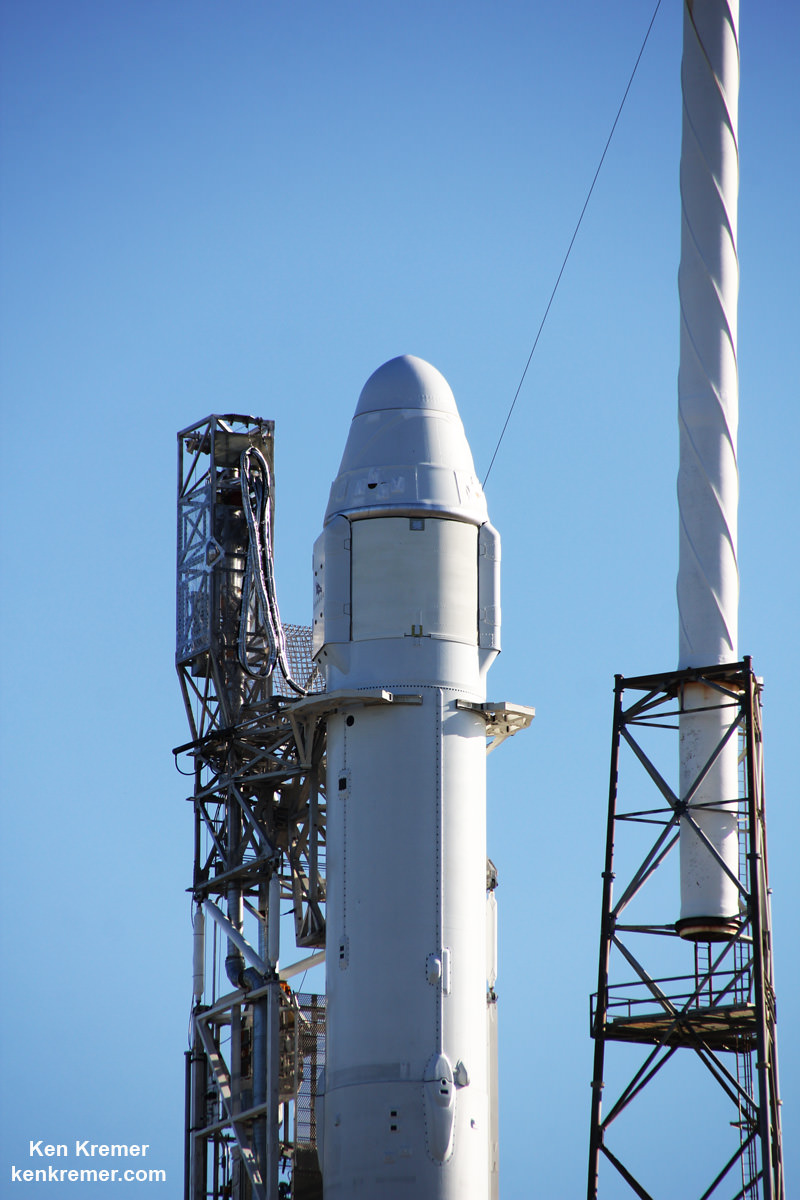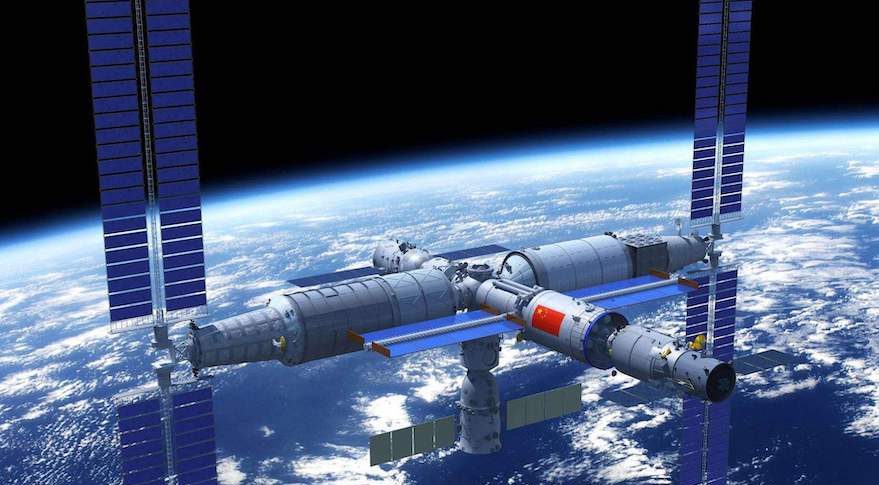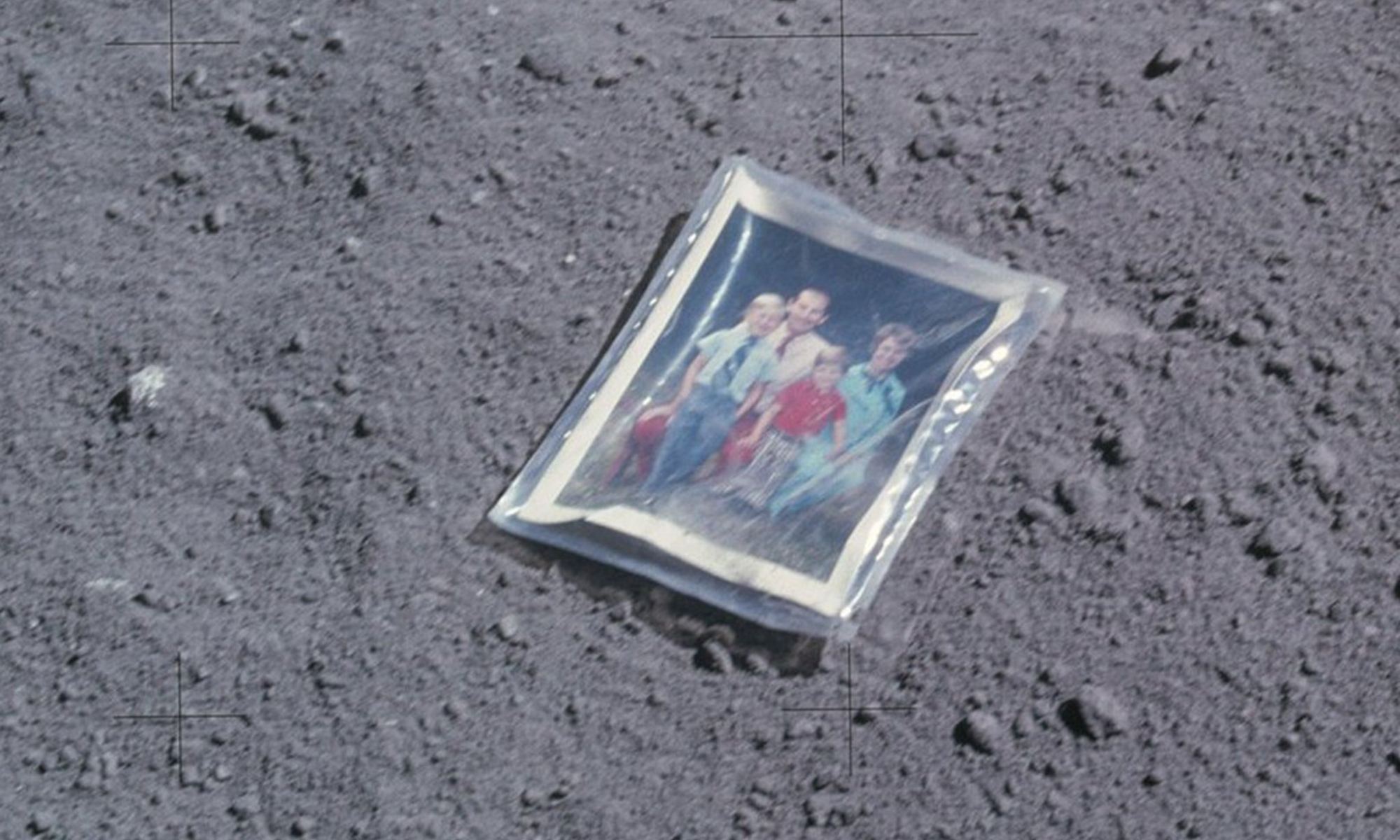The Chinese space agency is building a brand new space station, and they’re going about it in a suitably impressive way: an ambitious schedule of 11 planned launches crammed into only two years. When it’s done, the 66-ton space station will host crews of three astronauts for up to six months at a time, lasting for a planned 10 years before de-orbiting.
Continue reading “China will begin constructing its space station in 2021”Crew Dragon Will Be Launching on May 27th
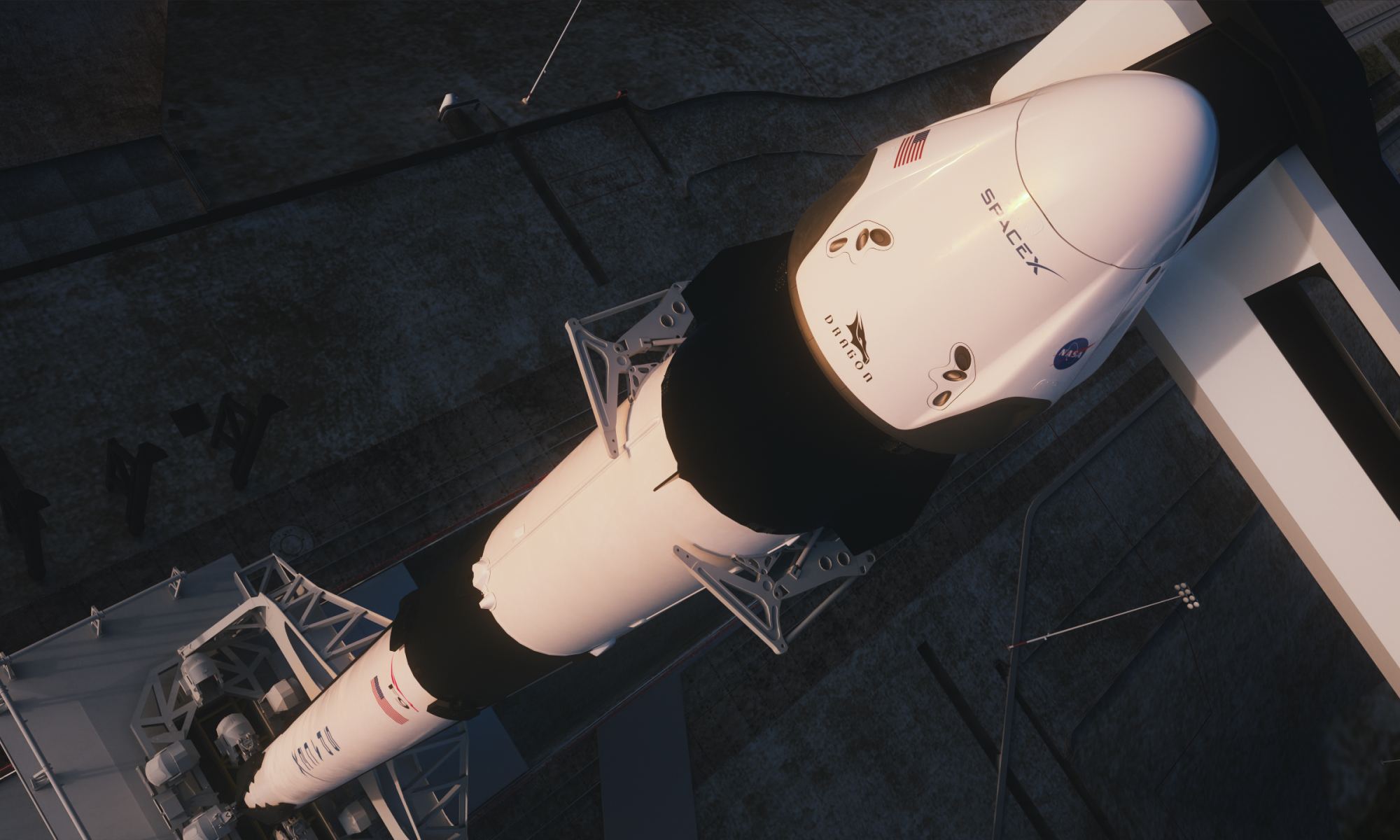
NASA and SpaceX are targeting May 27, 2020 for an historic mission: the launch of the first astronauts on the SpaceX Crew Dragon spacecraft, with the destination as the International Space Station (ISS). The crew, NASA astronauts Robert Behnken and Douglas Hurley, are scheduled to launch on a Falcon 9 rocket at 4:32 pm EDT that day from Kennedy Space Center’s Launch Complex 39A. If all goes well, the Crew Dragon will autonomously dock with the space station about 24 hours later.
Continue reading “Crew Dragon Will Be Launching on May 27th”Record-Setting Space Travelers Return to Earth
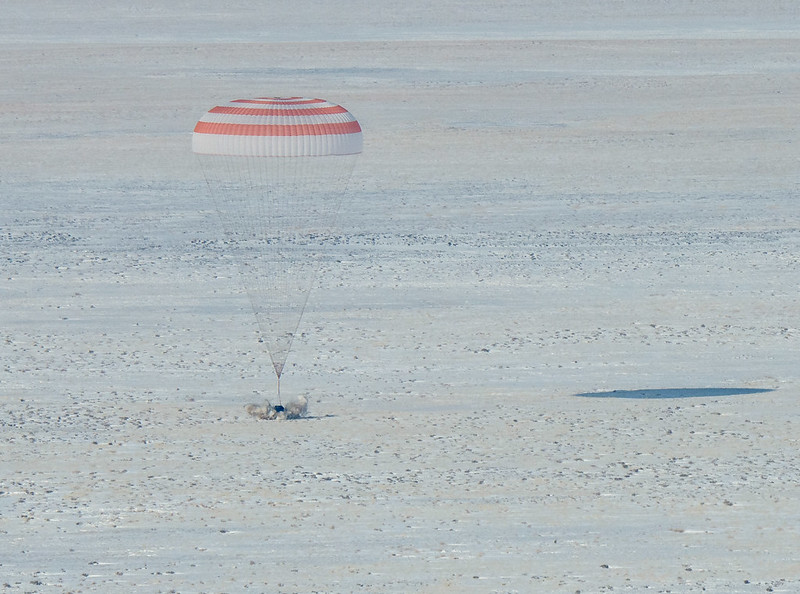
A trio of space travelers returned to Earth this morning from the International Space Station, including NASA astronaut Christina Koch, who set a record for the longest single spaceflight by a woman, at 326 straight days. Also coming home was ESA astronaut Luca Parmitano, who has now spent a total of 367 days in space (in two missions), more days than any ESA astronaut in history.
The crew of Expedition 61 also included Russian cosmonaut and Soyuz Commander Alexander Skvortsov, who completed his third mission for a total of 546 days in space, placing him 15th on the all-time time-in-space list.
Continue reading “Record-Setting Space Travelers Return to Earth”China’s Tiangong 2 was Destroyed Last Week, Burning up in the Atmosphere Over the South Pacific Ocean
On Friday, July 19th, China’s Tiangong-2 (“Heavenly Palace”) space laboratory successfully entered Earth’s atmosphere under controlled conditions and burned up above the South Pacific Ocean. This marked the successful completion of all of Tiangong-2’s tasks, which constituted China’s second attempt at testing their capability to conduct research and human operations in Low Earth Orbit (LEO).
Continue reading “China’s Tiangong 2 was Destroyed Last Week, Burning up in the Atmosphere Over the South Pacific Ocean”The Lunar Gateway Will be in a “Near-Rectilinear Halo Orbit”
After months of discussion, the space agencies behind the Lunar Gateway have decided how the space station will orbit the Moon. NASA and the ESA are developing the Lunar Gateway jointly, and the orbital path that it will follow around the Moon is a key part of mission design. It’ll affect all the vital aspects of the mission, including how spacecraft will rendezvous and land at the station.
Continue reading “The Lunar Gateway Will be in a “Near-Rectilinear Halo Orbit””Gateway Foundation Shows off Their Plans for an Enormous Rotating Space Station

Since the end of the Apollo-era, one of the main goals of NASA, Roscosmos and other space agencies has been the development of technologies that will enable a long-term human presence in space. These technologies will also help when it comes time to mount renewed missions to the Moon, to Mars, and other locations in the Solar System. Over the past few decades, these efforts have yielded Mir and the International Space Station (ISS).
In the coming years, these efforts will also lead to the Lunar Orbital Platform-Gateway and commercial space stations – like the Bigelow B330. And if private aerospace companies like the Gateway Foundation get their way, we’ll also have a spaceport in orbit around Earth. The company recently posted a video showing exactly what this rotating wheel space station will look like, and how companies like SpaceX could help build it.
Continue reading “Gateway Foundation Shows off Their Plans for an Enormous Rotating Space Station”Here’s How to Follow the De-Orbit of Tiangong-1, now Estimated to Happen Between March 30 and April 2
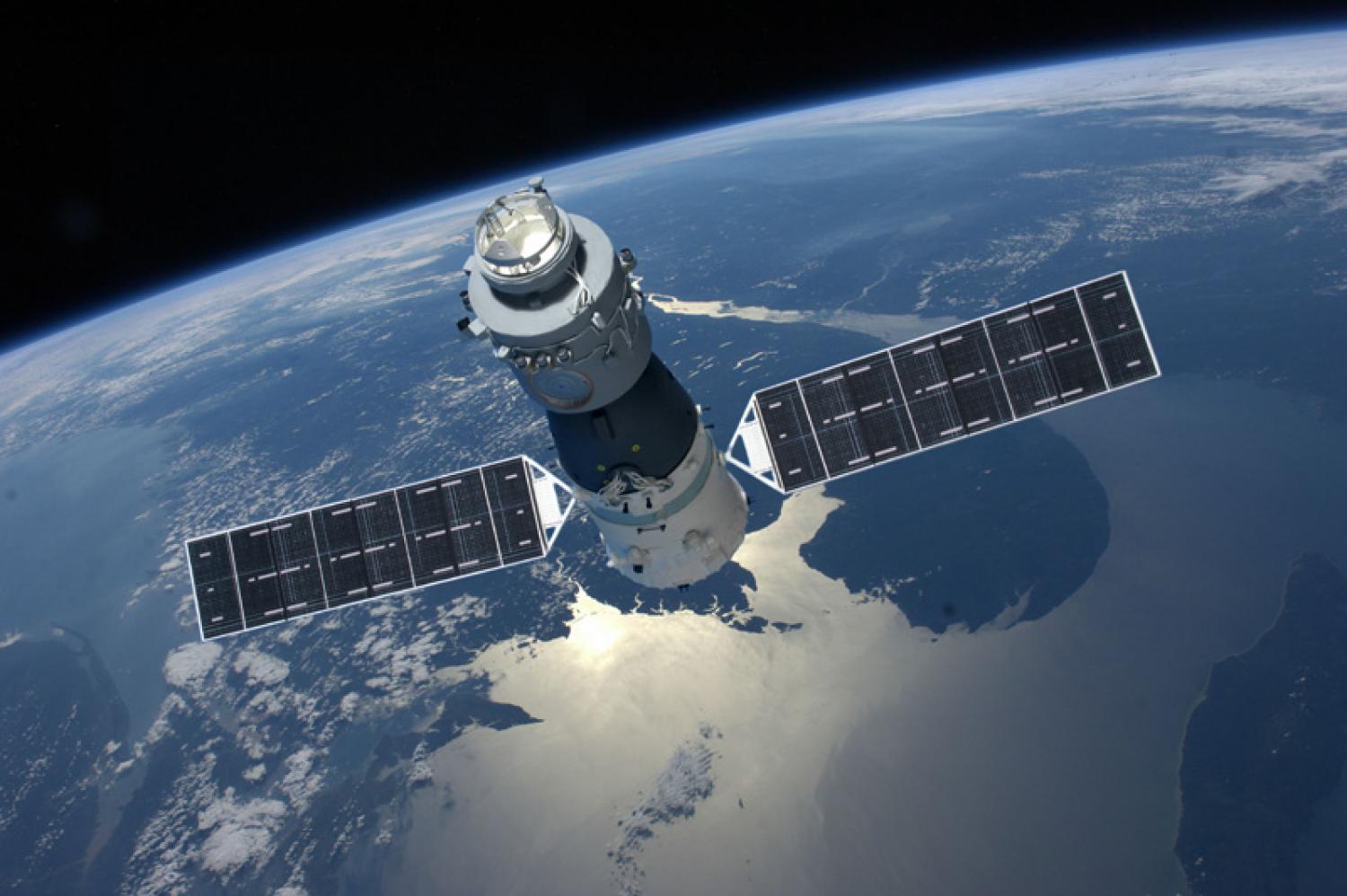
China’s Tiangong-1 space station has been the focus of a lot of international attention lately. In 2016, after four and half years in orbit, this prototype space station officially ended its mission. By September of 2017, the Agency acknowledged that the station’s orbit was decaying and that it would fall to Earth later in the year. Since then, estimates on when it will enter out atmosphere have been extended a few times.
According to satellite trackers, it was predicted that the station would fall to Earth in mid-March. But in a recent statement (which is no joke) the Chinese National Space Agency (CNSA) has indicated that Tiangong-1 will fall to Earth around April 1st – aka. April Fool’s Day. While the agency and others insists that it is very unlikely, there is a small chance that the re-entry could lead to some debris falling to Earth.
For the sake of ensuring public safety, the European Space Agency’s (ESA) Space Debris Office (SDO) has been providing regular updates on the station’s decay. According to the SDO, the reentry window is highly variable and spans from the morning of March 31st to the afternoon of April 1st (in UTC time). This works out to the evening of March 30th or March 31st for people living on the West Coast.
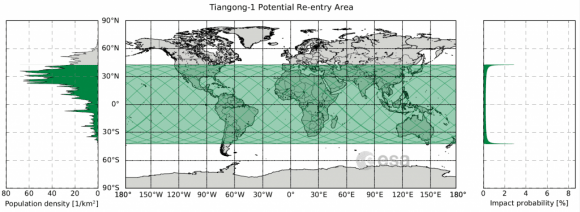
As the ESA stated on their rocket science blog:
“Reentry will take place anywhere between 43ºN and 43ºS. Areas above or below these latitudes can be excluded. At no time will a precise time/location prediction from ESA be possible. This forecast was updated approximately weekly through to mid-March, and is now being updated every 1~2 days.”
In other words, if any debris does fall to the surface, it could happen anywhere from the Northern US, Southern Europe, Central Asia or China to the tip of Argentina/Chile, South Africa, or Australia. Basically, it could land just about anywhere on the planet. On the other hand, back in January, the US-based Aerospace Corporation released a comprehensive analysis on Tiangong-1s orbital decay.
Their analysis included a map (shown below) which illustrated the zones of highest risk. Whereas the blue areas (that make up one-third of the Earth’s surface) indicate zones of zero probability, the green area indicates a zone of lower probability. The yellow areas, meanwhile, indicates zones that have a higher probability, which extend a few degrees south of 42.7° N and north of 42.7° S latitude, respectively.
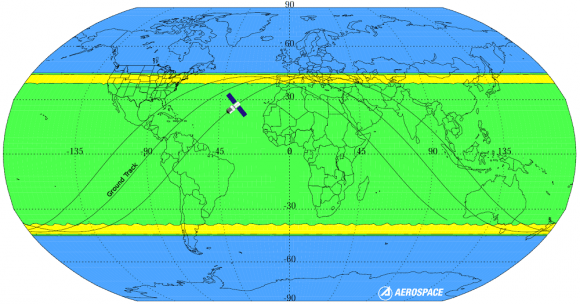
The Aerospace Corporation has also created a dashboard for tracking Tiangong-1 (which is refreshed every few minutes) and has come to similar conclusions about the station’s orbital decay. Their latest prediction is that the station will descend into our atmosphere on April 1st, at 04:35 UTC (March 30th 08:35 PST), with a margin of error of about 24 hours – in other words, between March 30th to April 2nd.
And they are hardly alone when it comes to monitoring Tiangong-1’s orbit and predicting its descent. The China Human Spaceflight Agency (CMSA) recently began providing daily updates on the orbital status of Tiangong-1. As they reported on March 28th: “Tiangong-1 stayed at an average altitude of about 202.3 km. The estimated reentry window is between 31 March and 2 April, Beijing time.”
The US Space Surveillance Network, which is responsible for tracking artificial objects in Earth’s orbit, has also been monitoring Tiangong-1 and providing daily updates. Based on their latest tracking data, they estimate that the station will enter our atmosphere no later than midnight on April 3rd.
Naturally, one cannot help but notice that these predictions vary and are subject to a margin of error. In addition, trackers cannot say with any accuracy where debris – if any – will land on the planet. As Max Fagin – an aerospace engineer and space camp alumni – explained in a recent Youtube video (posted below), all of this arises from two factors: the station’s flight path and the Earth’s atmosphere.
Basically, the station is still moving at a velocity of 7.8 km/sec (4.8 mi/s) horizontally while it is descending by about 3 cm/sec. In addition, the Earth’s atmosphere shrinks and expands throughout the day in response to the Sun’s heating, which results in changes in air resistance. This makes the process of knowing where the station’s will make its descent difficult to predict, not to mention where debris could fall.
However, as Fagin goes on to explain, once the station reaches an altitude of 150 km (93 mi) – i.e. within the Thermosphere – it will begin falling much faster. At that point, it be much easier to determine where debris (if any) will fall. However, as the ESA, CNSA, and other trackers have emphasized repeatedly, the odds of any debris making it to the surface is highly unlikely.
If any debris does survive re-entry, it is also statistically likely to fall into the ocean or in a remote area – far away from any population centers. But in all likelihood, the station will break up completely in our atmosphere and produce a beautiful streaking effect across the sky. So if you’re checking the updates regularly and are in a part of the world where it can be seen, be sure to get outside and see it!
Further Reading: GB Times
In mid-March, the Chinese Tiangong-1 Space Station is Going to Come Crashing Back Down to Earth… Somewhere

In September of 2011, China officially joined the Great Powers in Space club, thanks to the deployment of their Tiangong-1 space station. Since then, this prototype station has served as a crewed orbital laboratory and an experimental testbed for future space stations. In the coming years, China hopes to build on the lessons learned with Tiangong-1 to create a larger, modular station in 2023 (similar to the International Space Station).
Though the station’s mission was originally meant to end in 2013, the China National Space Agency extended its service to 2016. By September of 2017, the Agency acknowledged that they had lost control of the station and indicated that it would fall to Earth later in the year. According to the latest updates from satellite trackers, Tianglong-1 is likely to be reentering our atmosphere in March of 2018.
Given the fact that the station measures 10 by 3.35 meters (32.8 by 11 ft), weighs a hefty 8,506 kg (18,753 lb) and was built from very durable construction materials, there are naturally concerns that some of it might survive reentry and reach the surface. But before anyone starts worrying about space debris falling on their heads, there are a few things that need to be addressed.
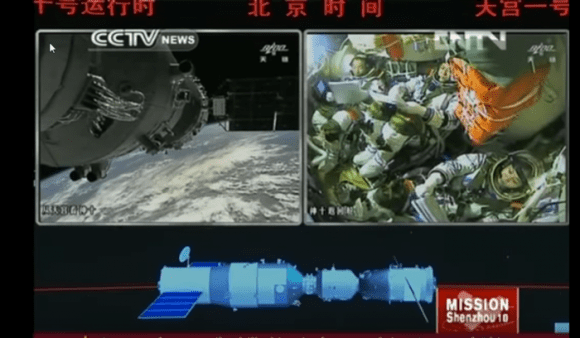
For starters, in the history of space flight, there has not been a single confirmed death caused by falling space debris. Tthanks to the development of modern tracking and early warning systems, we are also more prepared than at any time in our history for the threat of falling debris. Statistically speaking, you are more likely to be hit by falling airplane debris or eaten by a shark.
Second, the CNSA has emphasized that the reentry is very unlikely to pose a threat to commercial aviation or cause any impact damage on the surface. As Wu Ping – the deputy director of the manned space engineering office – indicated at a press conference back on September 14th, 2017: “Based on our calculation and analysis, most parts of the space lab will burn up during falling.”
In addition, The Aerospace Corporation, which is currently monitoring the reentry of Tiangong-1, recently released the results of their comprehensive analysis. Similar to what Wu stated, they indicated that most of the station will burn up on reentry, though they acknowledged that there is a chance that small bits of debris could survive and reach the surface. This debris would likely fall within a region that is centered along the orbital path of the station (i.e. around the equator).
To illustrate the zones of highest risk, they produced a map (shown below) which indicates where the debris would be most likely to land. Whereas the blue areas (that make up one-third of the Earth’s surface) indicate zones of zero probability, the green area indicates a zone of lower probability. The yellow areas, meanwhile, indicates zones that have a higher probability, which extend a few degrees south of 42.7° N and north of 42.7° S latitude, respectively.

To add a little perspective to this analysis, the company also indicated the following:
“When considering the worst-case location (yellow regions of the map) the probability that a specific person (i.e., you) will be struck by Tiangong-1 debris is about one million times smaller than the odds of winning the Powerball jackpot. In the history of spaceflight, no known person has ever been harmed by reentering space debris. Only one person has ever been recorded as being hit by a piece of space debris and, fortunately, she was not injured.”
Last, but not least, the European Space Agency’s Inter Agency Space Debris Coordination Committee (IADC) will be monitoring the reentry. In fact, the IADC – which is made up of space debris and other experts from NASA, the ESA, JAXA, ISRO, KARI, Roscosmos and the China National Space Administration – will be using this opportunity to conduct a test campaign.
During this campaign, participants will combine their predictions of the reentry’s time window, which are based on respective tracking datasets obtained from radar and other sources. Ultimately, the purpose of the campaign is to improve prediction accuracy for all member states and space agencies. And so far, their predictions also indicate that there is little cause for concern.
As Holger Krag, the Head of ESA’s Space Debris Office, indicated in a press statement back in November:
“Owing to the geometry of the station’s orbit, we can already exclude the possibility that any fragments will fall over any spot further north than 43ºN or further south than 43ºS. This means that reentry may take place over any spot on Earth between these latitudes, which includes several European countries, for example. The date, time and geographic footprint of the reentry can only be predicted with large uncertainties. Even shortly before reentry, only a very large time and geographical window can be estimated.”
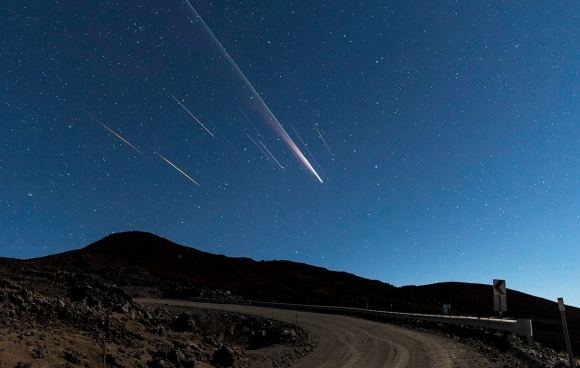
The ESA’s Space Debris Office – which is based at the European Space Operations Centre in Darmstadt, Germany – will follow this campaign in February with an international expert workshop. This workshop (which will run from February 28th to March 1st, 2018) will focus on reentry predictions and atmospheric break-up studies and allow experts in the field of space debris monitoring to share their latest findings and research.
In the current age of renewed space exploration and rapidly improving technology, every new development in space is an opportunity to test the latest instruments and methods. The reentry of Tiangong-1 is a perfect example, where the reentry of a space station is being used to test our ability to predict falling space debris. It also highlights the need for tracking and monitoring, given that humanity’s presence in orbit is only going to increase in the coming years.
In the meantime, it would not be inadvisable to keep your eyes on the skies this coming March. While there is little chance that debris will pose a hazard, it is sure to be spectacular sight for people who live closer to the equator!
Further Reading: Aerospace.org, ESA, Xinhuanet
SpaceX Resuming Launches from Damaged Pad 40 on Dec. 4 with Station Resupply Flight for NASA; Covert Zuma Remains on Hold
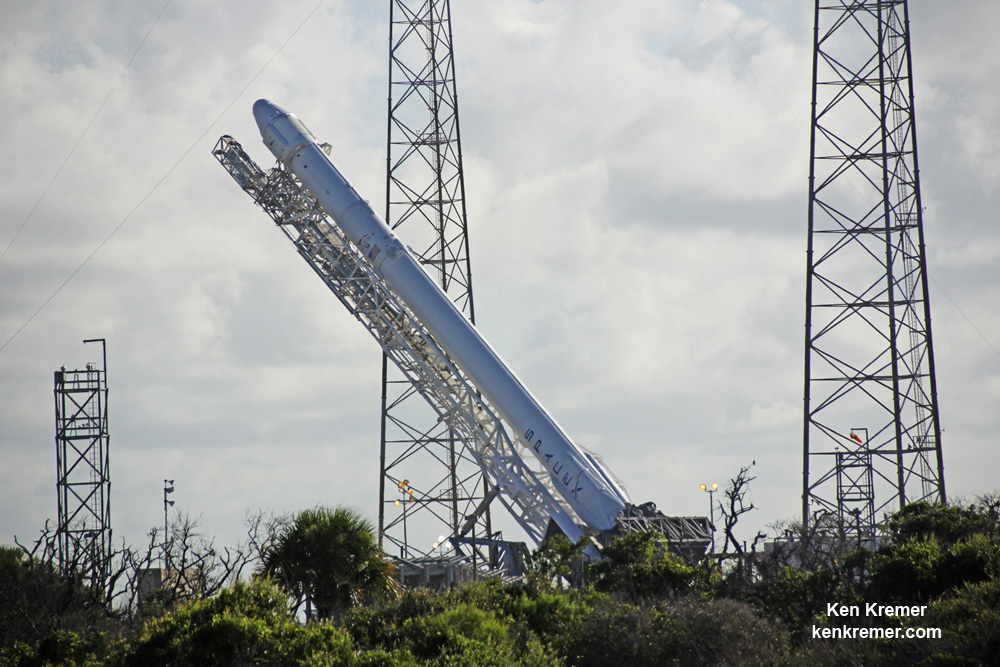

KENNEDY SPACE CENTER, FL – After postponing last week’s liftoff of the covert ‘Zuma’ spy satellite due to last minute concerns about the reliability of the payload fairing encapsulating it while poised for liftoff at KSC pad 39, SpaceX is set to at last resume launches from their previously damaged and now repaired Cape Canaveral pad 40 with a cargo resupply mission for NASA to the International Space Station (ISS) on Dec 4.
NASA and SpaceX have jointly decided to move forward with the Dragon CRS-13 cargo blastoff apparently because the mission does not involve use of the problematical payload fairing that halted last weeks planned Falcon 9 launch with the rocket and the mysterious Zuma payload.
Zuma was ready and waiting at pad 39A for the GO to launch that never came.
Then after a series of daily delays SpaceX ultimately announced a ‘stand down’ for super secret Zuma at pad 39A on Friday, Nov. 17, for the foreseeable future.
SpaceX engineers also had to deal with the after effects of a fire that broke out on a Merlin engine test stand during preparations for a hot fire test that resulted from a leak during a ‘LOX drop’ that halted testing of the Block 5 version of the Merlin 1D.
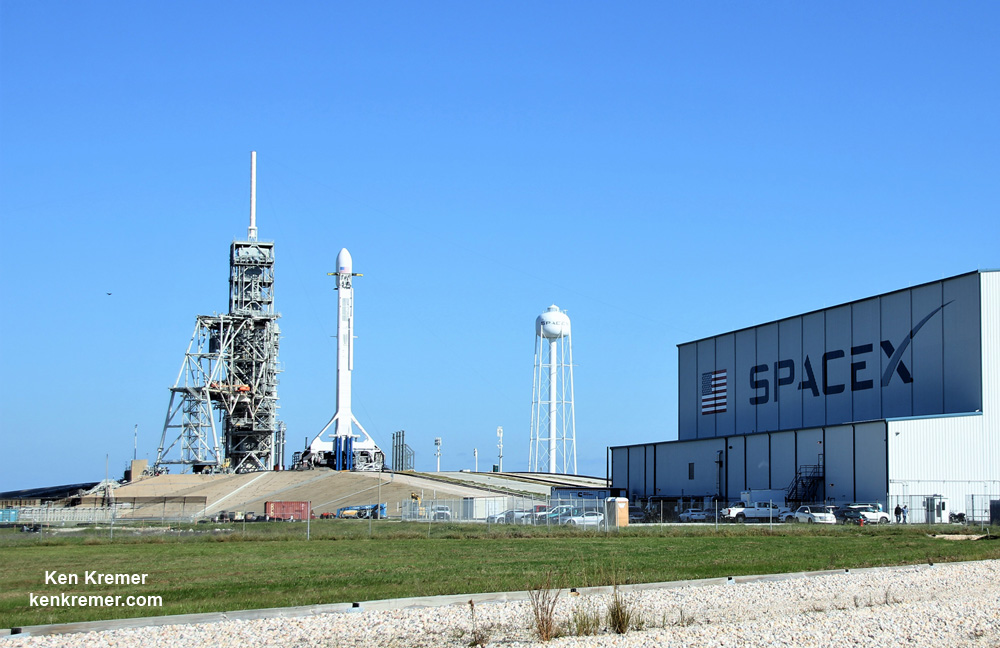
Since SpaceX’s gumdrop shaped Dragon cargo freighter launches as a stand alone aerodynamically shielded spacecraft atop the Falcon 9, it does not require additional protection from atmospheric forces and friction housed inside a nose cone during ascent to orbit unlike satellites with many unprotected exposed surfaces, critical hardware and delicate instruments.
Thus Dragon is deemed good to go since there currently appear to be no other unresolved technical issues with the Falcon 9 rocket.
“NASA commercial cargo provider SpaceX is targeting its 13th commercial resupply services mission to the International Space Station for no earlier than 2:53 p.m. EST Monday, Dec. 4,” NASA announced on the agency blog and social media accounts.
The Dec. 4 launch date for Dragon CRS-13 was announced by NASA’s space station manager Dan Hartman during the Orbital ATK Antares/Cygnus launch campaign that culminated with a successful blastoff last Sunday, Nov 12 from NASA’s Wallops Flight Facility on Virginia’s eastern shore.
But the targeted Dec 4 liftoff from Space Launch Complex 40 on Cape Canaveral Air Force Station, FL, was cast in doubt after SpaceX disclosed the payload fairing issue related launch delay on Friday.
Since last week SpaceX engineers have been busy taking the time to carefully scrutinize all the pertinent fairing data before proceeding with the top secret Zuma launch.
“We have decided to stand down and take a closer look at data from recent fairing testing for another customer,” said SpaceX spokesman John Taylor last Friday.
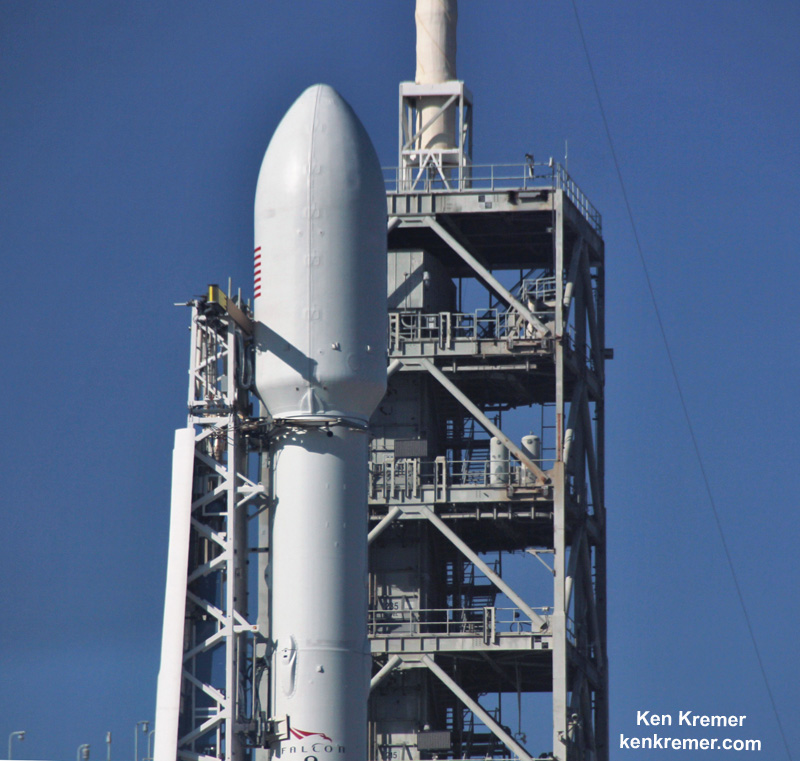
All of SpaceX’s launches this year from Florida’s Spaceport have taken place from NASA’s historic Launch Complex-39A at the Kennedy Space Center.
Pad 39A became SpaceX’s only operational Florida Space Coast launch pad following a catastrophic launch pad accident last year on Sept. 1, 2016 that took place during a routine fueling test that suddenly ended in a devastating explosion and fire that completely consumed the Falcon 9 rocket and Amos-6 payload and heavily damaged the pad and support infrastructure.

Since the Amos-6 accident workers raced to finish refurbishments to NASA’s long dormant pad 39A to transform into operational status and successfully launched a dozen missions this year.
Simultaneously additional crews have been hard at work to repair damaged pad 40 so that flights can resume there as soon as possible for the bulk of NASA, commercial and military contracted missions.
Meanwhile SpaceX wants to upgrade pad 39A to launch the Falcon Heavy and crewed Dragon flight. But those launches cant take place until pad 40 resumes operational status.
The Dragon CRS-13 mission was recently announced as the maiden mission for the reopening of pad 40.
Altogether Dragon CRS-13 will count as the fourth SpaceX Dragon liftoff of 2017.
The 20-foot high, 12-foot-diameter Dragon CRS-13 vessel will carry about 3 tons of science and supplies to the orbiting outpost and stay about 4 weeks.
It will be a reused Dragon that previously flew on the CRS-6 mission.
“The Dragon [CRS-13] spacecraft will spend about a month attached to the space station,” NASA said.
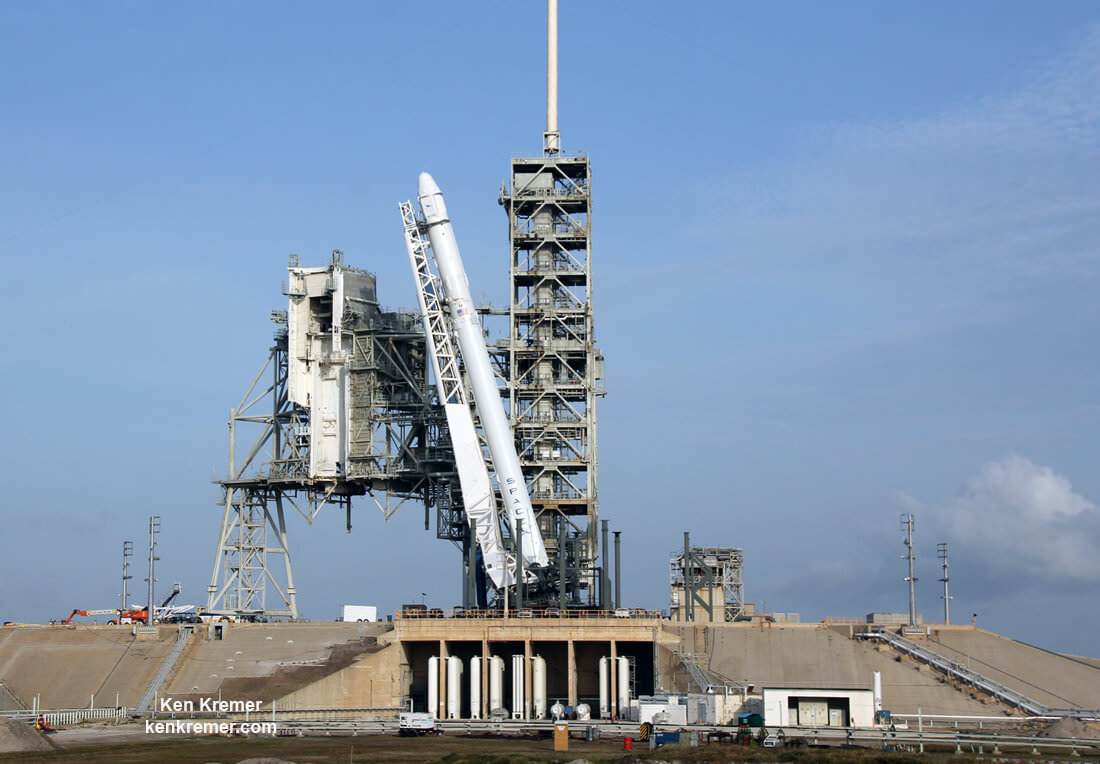
The prior Dragon CRS-12 resupply ship launched from pad 39A on Aug. 14, 2017 from KSC pad 39A and carried more than 6,400 pounds ( 2,900 kg) of science experiments and research instruments, crew supplies, food water, clothing, hardware, gear and spare parts to the million pound orbiting laboratory complex.
Dragon CRS-9 was the last ISS resupply mission to launch from pad 40 on July 18, 2016.
The recently arrived Orbital ATK Cygnus cargo ship is expected to depart the station from the Earth facing Unity node on Dec. 3 to make way for Dragon’s berthing at the Harmony node.
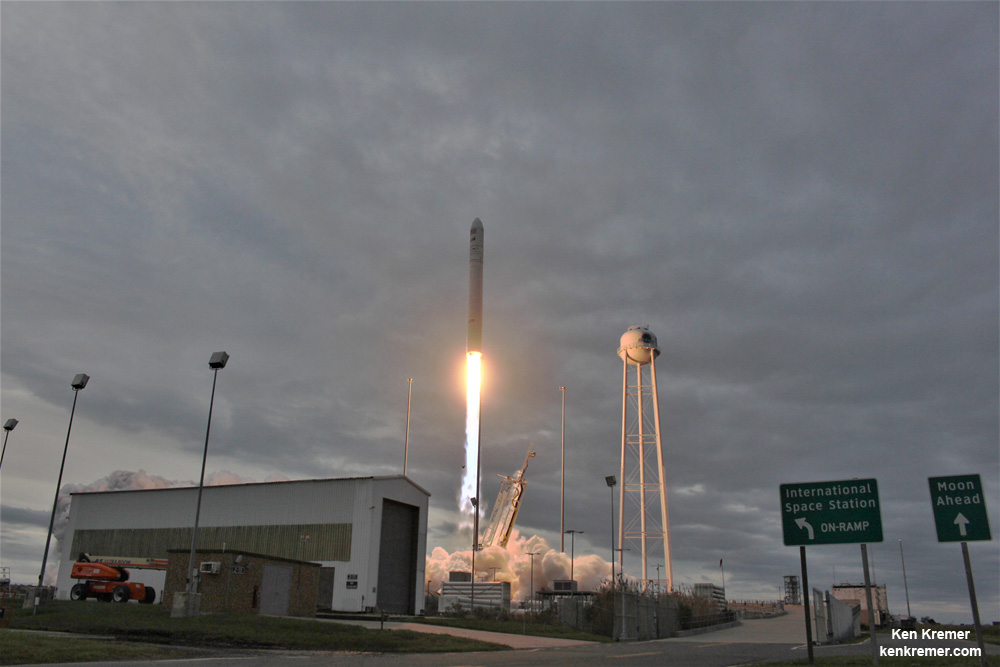
Watch for Ken’s continuing onsite coverage of SpaceX CRS-13, Zuma and KoreaSat-5A & Orbital ATK OA-8 Cygnus and NASA and space mission reports direct from the Kennedy Space Center and Cape Canaveral Air Force Station, Florida.
Stay tuned here for Ken’s continuing Earth and Planetary science and human spaceflight news.
